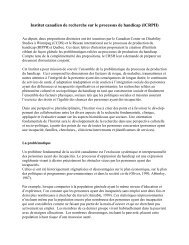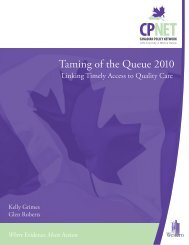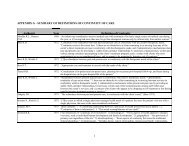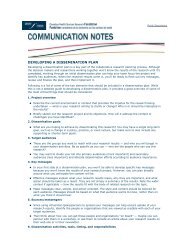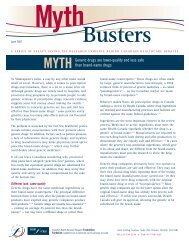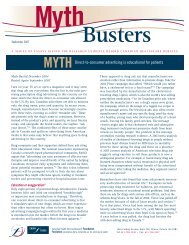Full Report - Fondation canadienne pour l'amélioration des services ...
Full Report - Fondation canadienne pour l'amélioration des services ...
Full Report - Fondation canadienne pour l'amélioration des services ...
Create successful ePaper yourself
Turn your PDF publications into a flip-book with our unique Google optimized e-Paper software.
Information transfer from ED to PCP<br />
Mo<strong>des</strong> of communication already in place between the ED and family physicians were<br />
maintained over the study period. The standard method of communication at the JGH-ED is to<br />
send a copy of the ED notes by mail to the family physicians associated with the JGH of patients<br />
presenting to the ED. The copy is the first page of the patient’s ED notes that may include<br />
information similar to the SCS. This method was used for the control group. As for the<br />
intervention group, information transfer was through SCS as well as through the standard mode<br />
which is the sending of a carbonated copy of the ED note by mail.<br />
Information transfer from PCP to ED<br />
For consented patients (intervention and control arms), medical information was collected from<br />
the chart and emergency physicians. For the visits in the intervention arm, patient charts were<br />
flagged (annex I) so that the treating ED physician could identify that patient is part of the study<br />
(intervention arm). Emergency physicians could then ask the research assistants to contact the<br />
FP and obtain the information requested. To facilitate the medical information transfer requested<br />
by the ED, FPs offices and the ED were equipped with dedicated fax lines. As well, the FPs<br />
secretaries were instructed to give priority to such requests. A fax form was specifically<br />
developed (annex I) for the study. A RA would communicate the information faxed back from<br />
the PCP office to the ED physician.<br />
Evaluation of the impact of SCS tool<br />
The first part of the analysis was to compare if the control and intervention arms were alike as<br />
for socio demographic. Six variables were used for baseline comparison: age, gender, LOS,<br />
admission, ambulance and stretcher. The primary outcomes included: resource utilization in and<br />
out of ED (in FP office) and continuity of care. Secondary outcomes included: FP satisfaction<br />
with SCS tool, FP practice satisfaction, FP perceived knowledge of patients, patient satisfaction<br />
and patient’ representation of their FP. For each outcome, comparisons were done between the 2<br />
groups (intervention and control). Due to the study <strong>des</strong>ign the analysis on resource utilization<br />
and continuity of care were performed considering the cluster (FP cluster) and lag effect (crossover<br />
adaptation curve to new group).<br />
14




